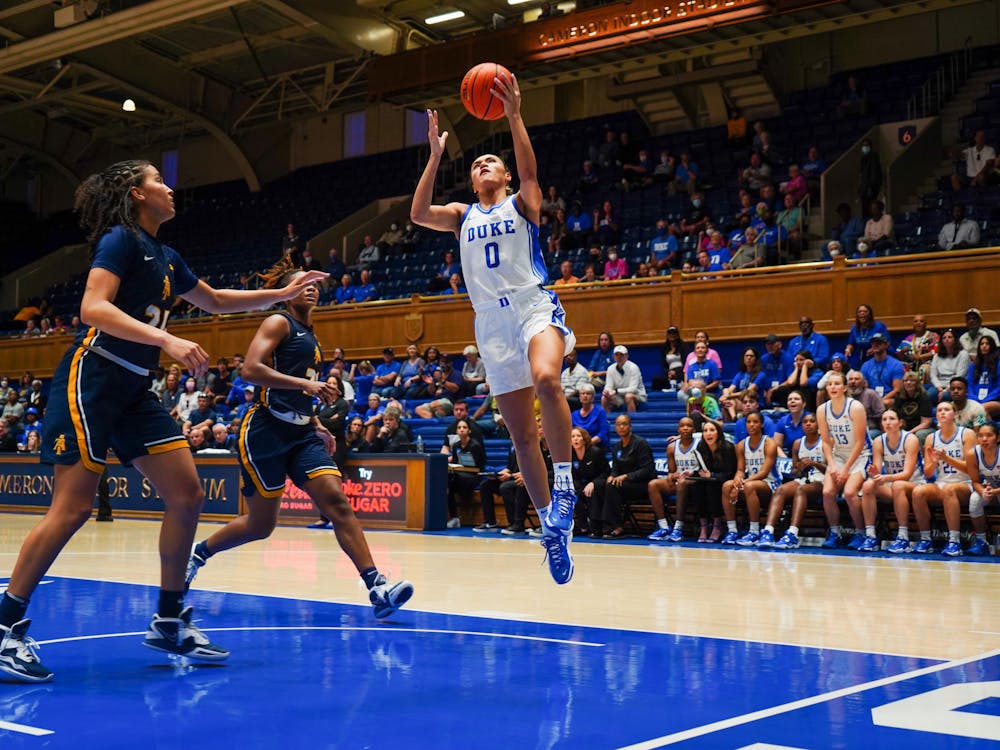For the last few seasons, Duke head coach Kara Lawson has often emphasized her main goal for offense: She wants to play fast. One of the main qualities of the 2022-23 squad she has touted is its athleticism, which lends itself to an effective transition offense.
“A lot of our players really excel in a transition game with their athleticism so, hopefully, we can be disruptive enough that it’s something we can do throughout the year,” Lawson said of Duke's full-court-press-to-fast-break defensive strategy after playing Charleston Southern Nov. 10.
And Duke certainly used this to its advantage the best it could Sunday night in its 54-41 win over Oregon State; 20 of its points came off of turnovers, with 17 coming on fast breaks.
“I was just yelling at ‘em, to ‘Run! Run! Run!’” Lawson said after the game. “[Oregon State] did a good job of slowing the pace down of the game, and we were trying to make it faster.”
But it certainly wasn’t a perfect scheme—it was an “ugly game,” Lawson said. At one point, the Beavers committed six straight turnovers and Duke only converted one of them into a layup.
Ultimately, Duke’s game against the Beavers, as well as its Friday evening loss to No. 3 UConn, exposed where its transition offense can be of help—and where it can go wrong.
“I just wish we would convert some more of the transition opportunities; I thought we left a lot of those on the table, especially in the second half. So we’ve got to work on our spacing and our passing in transition,” Lawson said Sunday night.
Some early foul calls put the first dent in Duke’s transition capabilities; the Blue Devils had four by the time the first quarter was halfway over, two of which were on off-ball screens. This resulted in several key members of the transition offense, including sophomore guard Shayeann Day-Wilson and junior center Kennedy Brown, finding themselves on the bench for extended periods of time as Lawson tried to prevent them from fouling out.
And on top of now missing key players and having to be cautious in transition for fear of more offensive fouls, the Blue Devils in general seemed flustered on offense, particularly in the second half. This culminated in several unforced turnovers, such as in the third quarter when junior guard Vanessa de Jesus and junior forward Elizabeth Balogun were called for turnovers on back-to-back finishing attempts in transition.
It is also hard to find any offensive momentum when the shots just aren’t falling. Duke finished shooting 34.8% from the floor Sunday night; it went 8-for-20 on layups, but its biggest Achilles’ heel on the scoring front was its jumpers, as Duke missed 19 against the Beavers. The Blue Devils were also exposed against UConn for not having nearly as many finishers as the Huskies, as UConn outscored Duke 15-3 in transition. Both games in the Phil Knight Legacy highlighted Duke’s need to identify key finishers on its squad, though senior guard Celeste Taylor, Brown and Balogun look to be promising.
Lawson has also noted that Duke’s size is an effective factor in transition, with Brown leading the team at 6-foot-6, but it faced difficulties going up in the paint against 6-foot-9 Jelena Mitrovic of the Beavers. Mitrovic tallied three blocks and also grabbed eight defensive rebounds for Oregon State, limiting the Blue Devils’ second-chance opportunities on a night when they were already struggling to find the basket.
“Every time we got the ball, we were just imploring the group that was on the floor to sprint to try and get the pace going a little bit higher, because we felt like that’s a game that’s in our favor, especially with [Oregon State’s] size,” Lawson said. “I don’t know that that’s [great coaching]. I was just yelling at them to keep running.”
The key to most of Duke’s offensive success, and a player who has shown the ability to lead Duke’s transition attempts throughout the season, was Taylor, who finished with 18 points, six steals and four assists against Oregon State. Her speed and competitive nature help her force turnovers on the defensive end, and her court vision helped her subsequently get down the court to find open teammates or to capitalize herself.
But Duke saw against UConn that it cannot just rely on its star players to propel itself to victories because (1) they have the potential to be inconsistent and (2) the rest of the rotation has not always stepped up when it needs to.
So far, transition offense has proven to be a solid attack Duke has up its sleeve, as it was against Oregon State. But with high turnover numbers in its last few games and some recent shooting woes, Duke still has some pieces to put together to make this a reliable system for the rest of the season.
Get The Chronicle straight to your inbox
Signup for our weekly newsletter. Cancel at any time.

Leah Boyd is a Pratt senior and a social chair of The Chronicle's 118th volume. She was previously editor-in-chief for Volume 117.

